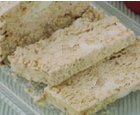|
Italian Dessert Frozen Sweet Cream A delicious Italian ice cream, traditionally with chopped almonds and cherries. We add crumbled macaroons instead. Simply heavenly.
In a large bowl, beat both creams with sugar till soft peaks form. Freeze for about 1 hour, till firm but not hard. Toss macaroon crumbs with toasted almonds and beat 2/3 of the maroon mixture, along with the Marsala, into the firm whipped cream mixture. Beat egg whites till stiff and fold gently into cream-macaroon mixture. Pour mix into a loaf pan. Cover with plastic wrap and freeze till quite firm, a good 3-4 hours. To unmold, quickly run bottom of the pan under hot tap water. Turn upside down onto a platter and shake loose. Sprinkle with remaining crumbled macarron-almond mix. Cut into slices and serve immediately. |
Tips & Glossary Arborio Rice: a medium-grained rice. Its high starch content yields a creamy texture and is the basis for risotto. Balsamic Vinegar: dark, thick vinegar with a sweet pungent flavor. Fermented, concentrated, and aged in wooden casks, sometimes up to 12 years. Can be pricey. Caper: salty, pickled bud of spiny shrub native to the Mediterranean region. Most prized is the non-pareil, the smallest (approx. 1/8”), though other sizes are tasty and less expensive. Formaggio: Cheese! Like France, Italy is a land of sublime cheeses, some 400 varieties. Here are some of the most widely sold in the U.S. Italian Seasoning: blend of dried herbs used in Italian cooking—marjoram, thyme, rosemary, savory, sage, oregano, and basil. Packaged commercially and found in most food stores. You can also make your own. Olive Oil: There's much more to know than is room for here. To learn all you need to know about the different grades of oil, and much, much more, head to Tanbourit. Pine Nuts: pinoli or pignoli; edible seeds of pine trees used in pesto sauce. Before cooking, release flavor by lightly browning in a heated skillet. Roasted peppers: buy or make your own: place under a broiler, or hold over a gas flame, till skin chars and blisters. Place in a closed paper bag for 15-20 minutes (to steam them). When cool, the skins slip off under water. Prosciutto: especially Prosciutto di Parma, dry-cured ham from Parma. The real deal! Cured up to 2 years, is almost sweet and very expensive. You can substitute with capicola, a delicious, light peppery ham.
|
Site by BOOM
![]()
LitLovers © 2024

